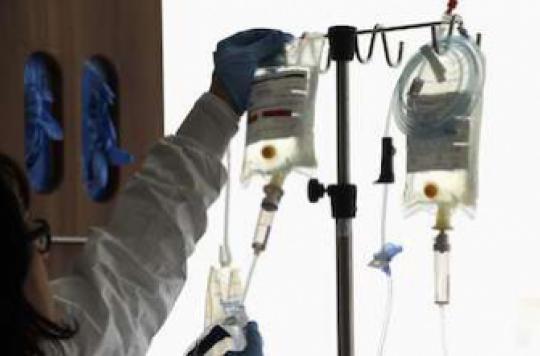It is associated with a rapid death, but little is known about it. Pancreatic cancer is the subject of a World Day which aims for better information. This disease is being better and better managed.

“Speak to me politely otherwise I’ll make you a pancreas… it’s very fast, the pancreas.” »This replica of Albert Dupontel, who embodies cancer in The sound of ice cubes (Bertrand Blier, 2009), is moving further and further away from reality. While still associated with a poor prognosis, pancreatic cancer no longer systematically results in death within a few months.
On the occasion of the 1st World Pancreatic Cancer Day, why actor takes stock of this little-known disease and its evolving treatments.
Late symptoms
Pancreatic cancer is distinguished from the more common forms of cancer. “By reputation, and it is a reality, pancreatic cancer is one of the most serious cancers and the therapeutic progress so far has been rather slow. Childhood lymph node disease is cured in almost 100% of cases today; in pancreatic cancer, 5% of people survive to 5 years ”, explains the Prof. Pascal Hammel, gastroenterologist at Beaujon hospital (Clichy), contacted by why actor. “It is also an aggressive cancer biologically: pancreatic tumors have mechanisms that cause cells to multiply rapidly, which is very difficult to slow down with drugs. The other peculiarity is its fairly silent development: symptoms appear when the cancer is relatively advanced. And for good reason: impossible to palpate or identify early symptoms.
Listen to Prof. Pascal Hammel, gastroenterologist at Beaujon hospital (Clichy): “ If someone has a stomach ache, the cancer has already passed the gland. The other major symptom is jaundice, linked to the fact that the cancer is pressing on the bile duct. “
Poor knowledge of risk factors
The risk factors for pancreatic cancer are relatively poorly identified. In two thirds of cases, no risk factor is associated with the development of tumors. Tobacco is considered to be the main culprit in the remaining cases. Obesity and diabetes evolving over the long term are also factors that promote cancer. Finally, in about 5% of cases, there is a family and genetic history.
Listen to Prof. Pascal Hammel : ” The BRCA 2 mutation gives rise to breast and ovarian cancer, etc. but can also promote pancreatic cancer. “
On the other hand, there is no question of generalizing the screening: pancreatic cancer is not frequent enough and its cure not sufficiently certain for it to represent a cost-effective solution.
Increasing incidence and mortality
Pancreatic cancer remains four times less common than colorectal cancer. In 2011, 9,000 new cases were reported and it is rising steadily. “It is a cancer that is increasing in frequency, like a certain number of cancers in Western circles”, explains thee Prof. Pascal Hammel. “Second, if it increases in frequency, it is not because there is an explosion; it’s because people get older and it’s a cancer that rather affects people over the age of 60. The third reason is that they are better diagnosed. “
Listen to Prof. Pascal Hammel : ” Twenty years ago, when an 85-year-old man in a town had jaundice, we said, maybe it’s hepatitis, a stuck stone, and we stopped there. “
By ricochet effect, mortality from pancreatic cancer is also increasing. “When I was an intern, we talked about 3,000 deaths per year. Now, we are talking about 10,000 – 12,000 dead ”, specifies the Prof. Hammel. But paradoxically, pancreatic cancer is less and less associated with rapid death.
Listen to Prof. Pascal Hammel : ” Many people continue to die. What is clear is that we are slowing down the progression of the disease, there is an increase in survival in the medium term. “
Progress in symptom management
This increased survival is explained by better management of the disease. Some forms of cancer allow surgery, which removes the part of the pancreas where the tumor is growing. In other cases, chemotherapy can slow down or even stop the progression of the cancer. Radiotherapy can be associated with it. These treatments are heavy but allow a significant extension of the life expectancy of a patient. But the main development in the management of pancreatic cancer is “supportive care.” “
“Jaundice or the compression that made you vomit can now be treated without operating. 15 or 20 years ago, when the intestine passed in contact with the pancreas (the duodenum), or when the bile duct was narrowed by the tumor, one had to operate and cut the bile duct or the intestine to sew it up elsewhere ” , add the Prof. Hammel. Now we can fix that by placing stents, springs like the ones we put in coronary artery. And in France, we are very good at that. “
Listen to Prof. Pascal Hammel, gastroenterologist: ” It is one of the most painful cancers. To treat it we have patches, cachets, nasal instillations … “
It is ultimately a message of hope that must be drawn from this 1st World Pancreatic Cancer Day: “In some patients, we have transformed this rapid illness into a disease which is not cured, which could kill the patient. one day but which is controlled, stabilized ”, concludes the Prof. Pascal Hammel.
“In the past, patients said they were afraid of dying and six months later they were no longer there. Now they are still scared of dying, and six months later they say, “Your chemo is good, but I’ve had enough, even though I’m fine.” After a year, they go. impatient. But we do not yet have, as with AIDS, the means to eradicate this disease. “
.















